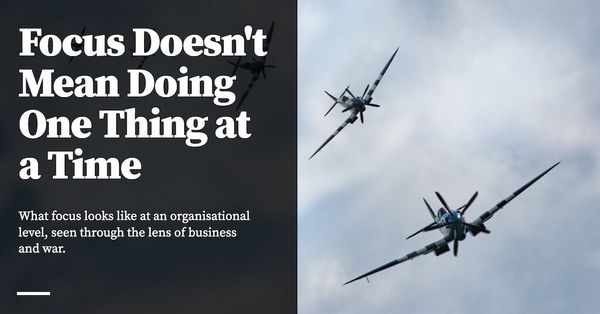Focus may be about saying no to good ideas, but it certainly doesn't mean doing one thing at a time. This is what focus looks like at an organisational level, told through the story of a business turnaround and the Marine Corps approach to war.
Last week’s essay was titled ‘Focus Is Saying No To Good Ideas’. One of the more interesting things I’ve noticed in the responses to that essay is that our ideas of ‘focus’ are usually informed by focus at an individual level. You probably know what this means: when a teacher or coach tells you to focus, they usually mean “do one thing at a time”, or “clear your mind of distractions”. And that’s certainly true when you’re studying for an exam or when you’re refining your tennis serve. But it’s not what focus looks like at the organisational level, and it’s not what Steve Jobs meant when he came up with that quip in the first place.
So what does it look like, really? We’ll take a look at two very different stories today, as an illustration of what focus looks like in an organisational context. Once again, I’m not laying out a comprehensive theory of organisational behaviour here — I’m merely giving you stories to demonstrate the ‘shape’ of the concept instantiation. This is what organisational focus looks like in business and in war. Let’s get started.
The Brooks Turnaround
In March 2001, Jim Weber took over as CEO of the beleaguered running shoe company, Brooks Running.
Brooks was then owned by private equity firm J.H. Whitney & Company. An initial turnaround under CEO Helen Rockey showed promise, but two CEOs on and the company was drifting: its financials were bad and the cash flow situation potentially catastrophic. Weber was an independent board member at Brooks at the time; he had front row seats to its decline. During a particularly bad board meeting, the board chairman, Ann Iverson, turned to Weber and said “Jim, you should be in here running this business.”
This was a provocative prompt. Weber took a few months to think it through. He eventually agreed.
At the point Weber took over, Brooks was in very bad shape. The company was structured as a typical private equity deal, which meant Whitney had raised debt to purchase Brooks and — naturally — put all of that debt on Brooks’s books. By the fall of 2000 the company was in crisis. Weber never really says in his autobiography how badly Brooks missed its interest payments, but things had gotten so bad that the banks involved were simply refusing to fund operations. There came a point where even the payroll checks were at risk of bouncing.
Whitney eventually agreed to recapitalise the company — to the tune of $7 million dollars. Weber made this a condition for his involvement: in March 2001, he spent a day with several partners in their Connecticut offices to access the problems and negotiate his appointment. On April 4, 2001, shortly after Whitney’s renewed commitment, Weber was named Brooks’s new CEO. He was its fourth in two years.
Weber came into the job with full understanding of the difficulties ahead of him. Brooks had 40 million dollars worth of debt on its books. The recapitalisation helped — it was one of the conditions that its banks had for continuing to fund operations, after all — but Brooks was still very much in trouble.
Weber had been thinking a fair bit about what he would do once he became CEO. On his first day at work he wrote ‘The secret to success is constancy of purpose’ — a Benjamin Disraeli quote — on his office whiteboard. He took this idea very seriously.
Originally published , last updated .
This article is part of the Operations topic cluster, which belongs to the Business Expertise Triad. Read more from this topic here→





